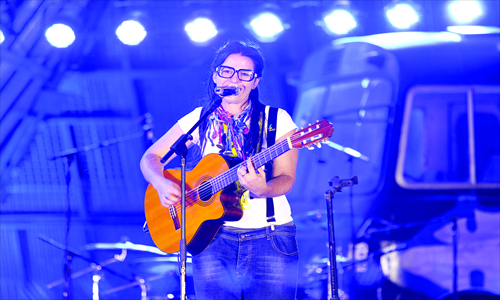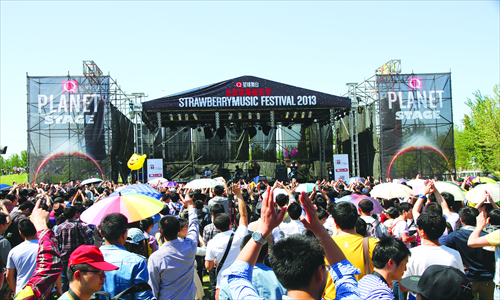Latin fever


Geographically speaking, Latin America is no nearer to Chinese people than the two poles of the earth, and a flight transporting you from Beijing to the continent will take more than a day off your calendar. Despite the fact that the art and culture of both places is eye-catching in the world, the distance has meant that cultural exchanges between the two has been sparse. As a result, most Chinese people know little about Latin American art, and vice versa.
But this spring is ushering in a fresh start for the introduction of Latin America's art into China. Under the framework of the annual Meet in Beijing Arts Festival (April 27 - May 30), the first Latin American Art Season has been launched in Beijing.
During the month-long festival, music groups from five Latin American countries - Cuba, Peru, Columbia, Uruguay and Ecuador - are meeting local audiences. There also is a series of art exhibitions constituting the first collective showing of Latin American art in China on such a large scale.
"This year is just a start, we are planning a regular Latin American art festival each year in China in the future," said Yin Peng, director of the American and Oceania division of the China International Exhibition Agency, one of the organizers of this year's Latin American art season.
"Historically, due to reasons of geography, we know little about their culture and art. Now with increasing economic and diplomatic exchanges, bringing this remote and exotic culture closer to Chinese people is very necessary," Yin told the Global Times.
Music on fire
During the Labor Day holiday between April 29 and May 1, a music group from Ecuador thrilled the audience at the Chaoyang Sports Center and Tongzhou Canal Park in Beijing. The band, Equilivre, with over 1 million views for their songs on YouTube, is one of the most popular rock bands in Latin America.
"The audience's mood was very high, with some shouting the band's name," said Wang Haifan, a music lover at the scene. "Their music style... was very infectious and interesting," said Wang.
Boasting global pop stars like Ricky Martin, singer of the 1998 World Cup theme-song "The Cup of Life," and Shakira who sang "Waka Waka" (This Time for Africa) for the 2010 South Africa World Cup, Latin American music is widely recognized for its passionate and vibrant tempo.
Absorbing various elements from Western, indigenous Indian and African music, contemporary Latin American music is dynamic, and mingled with a sense of lyricism and somberness, but not sadness. Employing mostly European musical instruments such as guitar, harp, accordion, saxophone and violin, Latin music is usually a combination of singing and dancing.
You may already be familiar with the name of some exciting dance styles like the habanera of Cuba, samba of Brazil, Peruvian waltz, and Argentine tango. But if you want to get a personal experience of Latin style, check out the Latin America Art Season's opening concert on May 13 where performers from Mexico, Argentina and Peru will bring Chinese audiences a live show.
"The opening concert will feature well-known local songs including 'Libertango' from Argentina, 'El condor pasa' from Peru and 'Concierto del sur' from Mexico by its famous composer Maria Ponce," said Tan Zhiqiang, vice director of Cultural Communication Center of the China Performing Arts Agency (CPAA), responsible for the introduction of Latin music during this year's Latin art season.
"Lively rhythm is only part of Latin music and Cuban songs best manifest this aspect. Meanwhile, folks from Peru and Ecuador present lyrical and somber elements inherited from local Indian and Spanish styles when the places were occupied by the latter in history," said Tan, "and for those Caribbean areas, black [African] music dominates."
Chinese audiences still know so little about these musical forms compared to European and American music, according to Tan. "There is a lot of work to do to nurture local audiences' interest in Latin music," he told the Global Times.
Reputed art
Unlike the signature impression of passion and enthusiasm that their music leaves in people's minds, Latin America's art works present a more diverse pattern under different artists' craftsmanship. However, just like its literature's great achievements in "magic realism," its art works are also accomplished in an unusually exotic and novel way.
"Modern and contemporary art in the region established its position in the world as early as the 1980s, most of which was under the influence of Western art (particularly Spanish and Portuguese art) and local Indian culture," said Yin.
In fact, the diversity of ethnic groups including indigenous Indians, Europeans, Jews, Africans and others in the continent have co-produced the hybrid that is Latin American art today, with its many schools of art like Indigenismo, Modernism, Expressionism and Constructivism all featured in local works.
As Yin mentioned, almost three decades ago, Latin American art works became an important part of collections at world leading art museums or auction houses. In the US, many leading museums including the Museum of Modern Art in New York, the Museum of Fine Arts in Houston, and the Los Angeles County Museum of Art have established a department of Latin American art.
And in the auction market, both Sotheby's and Christie's began to feature art works from this region in the early 1980s and later set up their division of Latin American art. Representative local artists like Rufino Tamayo (1899-1991) and Frida Kahlo (1907-54), both from Mexico, and Roberto Matta (1911-2002) from Chile consistently lead sales in this area.
However, at the current series of Latin American art exhibitions in Beijing, visitors won't be able to see works by those most famous artists.
"Most of the works exhibited this year are offered by their embassies, and they are also very reflective of local art, representing artists' thoughts on various social issues like environmental pollution or global warming," said Yin, "From next year on we will try a professional curating system and introduce more and specified works to Chinese visitors."